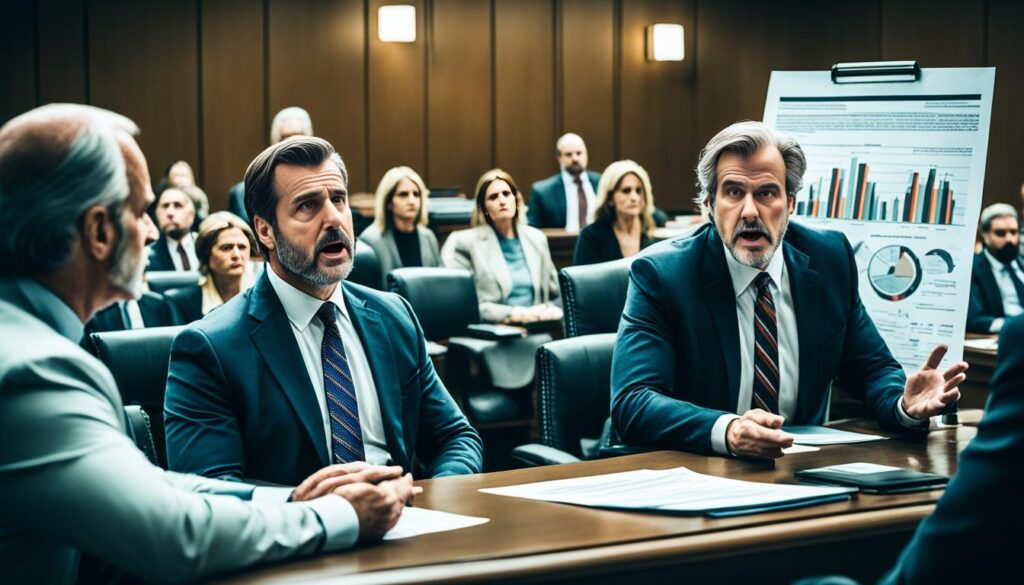Disclosure: This Post Contains Affiliate Links; We earn a commission on purchases.
As concerns about the potential health risks of electromagnetic fields (EMF) continue to grow, businesses must be aware of their legal responsibilities and liabilities in EMF management. Compliance with EMF safety regulations and risk assessments is crucial for protecting the well-being of both employees and the business as a whole.
In this article, we will explore the various legal obligations and requirements surrounding EMF management in the workplace. By understanding these responsibilities, businesses can take proactive measures to ensure compliance, minimize potential liabilities, and prioritize the safety of their workforce.
Key Takeaways:
- Understanding and fulfilling legal responsibilities in EMF management is essential for businesses.
- Compliance with EMF safety regulations is crucial for employee well-being.
- Developing an EMF management plan and implementing workplace guidelines are proactive steps.
- Minimizing potential liabilities requires staying up to date with EMF safety regulations.
- Protecting the health and safety of employees is a priority in EMF management.
Understanding EMF and Its Effects
Electric and magnetic fields (EMF) are present whenever there is an electric power source. These fields can vary from static fields to extremely low frequency (ELF) and intermediate frequency (IF) fields, as well as radio-frequency (RF) fields.
While there is growing public concern about the potential health effects of EMF exposure, it is important to note that personal injury claims based on EMF have not been successful in courts due to a lack of scientific evidence. However, property claims related to the perceived risk of EMF have seen more success, with courts awarding damages for diminished property value caused by public fears surrounding EMF.
It is crucial to understand the different types of EMF and their effects to address public concerns and mitigate potential liabilities.
- Static Fields: These are non-varying fields that exist around devices with a direct current, such as power lines or appliances. They have no proven detrimental effects on human health.
- Extremely Low Frequency (ELF) Fields: These fields are generated by power lines, electrical equipment, and household appliances. While there is no conclusive evidence of health risks from exposure to ELF fields, concerns have been raised and continue to be studied.
- Intermediate Frequency (IF) Fields: These fields are commonly produced by electronic devices like laptops, smartphones, and wireless routers. Similar to ELF fields, there is ongoing research to better understand the potential effects on human health.
- Radio-Frequency (RF) Fields: These fields are associated with wireless communication devices such as cell phones, Wi-Fi routers, and cell towers. RF fields are regulated to ensure compliance with safety standards, and research is ongoing to determine their long-term effects.
While personal injury claims related to EMF exposure have faced challenges in the courts, property claims based on public fears of EMF have seen more success. Courts have acknowledged the perceived risk of EMF and awarded damages for diminished property value. This indicates the importance of addressing public concerns surrounding EMF and taking appropriate measures to ensure the safety of individuals and properties.
Public Perception and Triggering Events
Public perception plays a crucial role in shaping attitudes and actions towards electromagnetic fields (EMF). Concerns surrounding EMF are more likely to gain traction when individuals perceive a significant risk and when there is a triggering event that captures their attention.
Triggering events can take various forms, such as the development of a serious health condition, news about the construction of a nearby power line, or changes in property purchase or school enrollment. These events can prompt individuals to become more aware of EMF and its potential implications, leading them to investigate the issue or file complaints.
Lack of Accurate Information and High Exposure Levels
One factor that can exacerbate public concerns about EMF is a lack of accurate information. Misinformation or a lack of accessible knowledge can contribute to heightened anxiety and the public perception of risk associated with EMF.
In addition, high levels of EMF exposure can also contribute to increased public concerns. When individuals are exposed to elevated EMF levels, they may attribute any health issues or symptoms they experience to EMF exposure, further fueling their perception of risk.
“It is important to provide accurate and reliable information to the public regarding EMF and its potential effects on health. By addressing concerns and promoting scientific understanding, we can help alleviate unnecessary fears and misinformation.”
Scientific Connection and Adverse Health Effects
Public perception of risk regarding EMF is often influenced by the possibility of a strong scientific connection between EMF and adverse health effects. While there is ongoing debate and research in this area, individuals may form opinions based on existing studies, anecdotal evidence, or media reports linking EMF exposure to health issues.
It is important to note that scientific consensus on the health effects of EMF is still evolving, and currently, there is no conclusive evidence supporting a direct causal relationship between EMF exposure and adverse health outcomes. However, the perception of risk can still be significant and lead to public concerns and demands for further investigations.

Overall, public perception of EMF risk is influenced by factors such as triggering events, accurate information availability, exposure levels, and the perception of a scientific connection to adverse health effects. Understanding these perceptions and addressing public concerns through education and clear communication can help foster a balanced and informed understanding of EMF-related risks.
Legal Conflicts and Litigation
EMF conflicts often result in litigation, including personal injury claims, property damage claims, and toxic tort litigation. However, the outcome of these legal battles varies depending on the type of claim.
Personal injury claims: Despite public concerns about the health effects of EMF exposure, personal injury claims related to EMF have not been successful in the courts. This is primarily due to the lack of scientific evidence linking EMF to specific health consequences. Without compelling scientific data, it is challenging for plaintiffs to establish a direct causal relationship between EMF and their alleged injuries.
Property damage claims: In contrast, property claims asserting that EMF has diminished property value have been more successful in litigation. Courts have awarded damages based on the public’s fears surrounding EMF. Various theories are applied in these cases:
- The liberal (majority) view: In this approach, courts consider the potential impact of EMF on property value, even if there is no direct evidence of harm. This allows plaintiffs to present evidence related to the perception of risk and the potential market devaluation.
- The intermediate view: Some courts take an intermediate approach, considering both the scientific evidence and the perception of risk. This view requires a stronger connection between EMF and property devaluation compared to the liberal view.
- The conservative (minority) view: This approach requires plaintiffs to demonstrate a direct and scientifically proven link between EMF exposure and property devaluation. Courts adopting the conservative view are less likely to award damages in property damage claims.
Additionally, the concept of preemption may come into play in EMF-related litigation. Preemption refers to situations where federal laws or regulations preempt state or local laws. This can impact the outcome of EMF lawsuits and the availability of legal remedies for plaintiffs.
Case Study: Johnson v. PowerCorp
“The court awarded Mrs. Johnson damages for diminished property value due to her fears of EMF exposure caused by the nearby power lines. The liberal view adopted by the court allowed the consideration of perceived risk and public fears, even in the absence of conclusive scientific evidence linking EMF to property devaluation.”
The table below summarizes the success rates of different types of EMF claims:
| Type of Claim | Success Rate |
|---|---|
| Personal Injury Claims | Low |
| Property Damage Claims | Medium to High |
| Toxic Tort Litigation | Varies |

Insurance Considerations
When it comes to managing the risks associated with electromagnetic fields (EMF), insurance considerations play a crucial role. Insurers recognize the potential dangers of EMF exposure and often rank it as a high-risk factor, alongside other pollutants such as lead and asbestos. As a result, many insurance policies now include specific exclusions related to electromagnetic fields.
These exclusions mean that insurance coverage may not extend to any bodily injury, personal injury, or property damage arising directly or indirectly from electromagnetic radiation. This can leave businesses and individuals vulnerable to potential liability claims in the event of EMF-related incidents.
“Many insurance policies have electromagnetic field exclusions, which means they do not cover bodily injury, personal injury, or property damage arising directly or indirectly from electromagnetic radiation.”
The decision to exclude EMF from insurance coverage stems from the ongoing debate about the long-term consequences of EMF exposure and the uncertain scientific consensus regarding its health effects. Insurance companies are understandably cautious about providing coverage in such circumstances, as the potential for liability claims arising from EMF-related incidents can be substantial.
To better understand the insurance landscape surrounding EMF, it is important for businesses and individuals to carefully review their insurance policies and seek clarification on whether EMF-related claims are covered. Taking proactive measures to protect against the financial implications of liability claims related to EMF is crucial for both business continuity and personal well-being.
Examples of Insurance Coverage and Exclusions
Below is an illustrative example of the type of table you could include to showcase the differences in insurance coverage and exclusions related to EMF:
| Insurance Provider | EMF Coverage | Exclusions |
|---|---|---|
| Insurance Company A | Covers bodily injury claims related to EMF | No coverage for property damage |
| Insurance Company B | No coverage for any claims arising from EMF exposure | Complete exclusion of all EMF-related incidents |
| Insurance Company C | Covers both bodily injury and property damage claims related to EMF | No specific exclusions for EMF |
Ensuring Adequate Insurance Coverage
Given the potential risks and liabilities involved, it is important to carefully assess the insurance coverage available for EMF-related incidents and consider obtaining additional coverage if necessary. A comprehensive insurance policy that provides coverage for bodily injury, personal injury, and property damage resulting from EMF exposure can help mitigate potential liabilities and ensure financial protection.
Insurance coverage for EMF-related incidents is an essential consideration for businesses and individuals alike. By understanding the exclusions and limitations within insurance policies and taking proactive steps to secure adequate coverage, they can protect themselves from potential liability claims and the long-term consequences associated with EMF exposure.
Wireless Companies and EMF Risk
Wireless companies play a significant role in the proliferation of electromagnetic fields (EMF) through their products and services. Surprisingly, these companies themselves acknowledge the potential risks associated with EMF exposure by defining electromagnetic fields as pollutants in their insurance policies.
While wireless companies warn their shareholders about the financial risks associated with EMF, they often fail to adequately inform users of their products or individuals exposed to their emissions about these potential hazards. This raises concerns about safety and potential liability for wireless companies.
| EMF Risk | Potential Consequences |
|---|---|
| Lack of proper warnings | Increased potential liability |
| Failure to address EMF concerns | Loss of public trust and credibility |
| EMF-related litigation | Financial losses due to legal expenses and settlements |
| Diminished market value | Impact on stock prices and shareholder investments |
Wireless companies must recognize the importance of addressing the EMF risks associated with their operations and products. By taking proactive measures to ensure proper warnings, address public concerns, and stay informed about EMF safety regulations, these companies can mitigate potential financial losses and safeguard their reputation.
Insurance Coverage and EMF Liability
Insurance companies play a critical role in managing the potential liabilities associated with electromagnetic fields (EMF). As EMF is often classified as a pollution risk, insurance providers typically require additional coverage for EMF-related liabilities. In this section, we explore the importance of insurance coverage for EMF and the potential risks businesses may face.
Electromagnetic Field Liability Insurance
Electromagnetic field liability insurance is designed to protect businesses against claims for bodily injury and property damage caused by EMF. This specialized coverage helps mitigate the financial risks associated with EMF-related liabilities. However, it is important to note that insurance companies may have limitations and exclusions related to EMF, which vary depending on the country and industry.
Understanding Potential Insurance Claims
Given the potential health concerns surrounding EMF and its impact on individuals, businesses need to assess their potential EMF risks and understand the types of insurance claims that may arise. Common insurance claims related to EMF liability include bodily injury claims and property damage claims.
Pollution Liability and EMF
Insurance companies classify EMF as a pollution risk due to its potential impact on health and the environment. As a result, businesses may need to secure additional pollution liability coverage to protect themselves from EMF-related risks. This coverage can help address any financial losses that may be incurred as a result of EMF-related liabilities.
Insurance Coverage Considerations
When evaluating insurance coverage for EMF, businesses should consider several factors. These include the extent of coverage provided, including any limitations or exclusions related to EMF. Additionally, businesses should assess the financial implications of potential insurance claims and ensure they have the necessary coverage to protect their assets and mitigate liability risks.
Case Study: EMF Liability Insurance for XYZ Corporation
To illustrate the importance of insurance coverage for EMF liability, let’s consider the case of XYZ Corporation, a leading telecommunications company. XYZ Corporation operates a vast network of wireless infrastructure, exposing them to potential EMF-related claims. By obtaining comprehensive EMF liability insurance, XYZ Corporation safeguards itself against potential bodily injury and property damage claims arising from EMF exposure. This coverage provides the company with financial protection and peace of mind.
As demonstrated by this case study, insurance coverage for EMF liability is essential for businesses operating in industries exposed to EMF risks. By securing appropriate coverage, businesses can protect themselves from potential losses and mitigate the financial implications of EMF-related liabilities.
Conclusion
Understanding and fulfilling legal responsibilities in EMF management is crucial for businesses to ensure compliance with safety regulations and minimize potential liabilities. By developing a comprehensive EMF management plan and implementing workplace guidelines, businesses can protect the health and safety of their employees, while also safeguarding their overall well-being.
Staying up to date with EMF safety regulations and regularly reviewing and updating the EMF management plan are essential steps in maintaining compliance and effectively managing electromagnetic fields in the workplace. Businesses should prioritize employee training and awareness programs to ensure that everyone understands the potential risks associated with EMF and knows how to follow the established guidelines.
By taking proactive measures and staying informed about the latest developments in EMF management, businesses can confidently navigate the legal landscape and fulfill their legal obligations. A comprehensive EMF management plan, combined with effective workplace guidelines, not only minimizes potential liabilities but also fosters a safe and healthy working environment for all.
Source Links
- https://www.jenner.com/a/web/4wrztq3m5wfU8kujto4MWJ/4HRMZQ/REFJForcade.pdf?1327948327
- https://biotech.law.lsu.edu/ieee/ieee27.htm
- https://ehtrust.org/key-issues/electromagnetic-field-insurance-policy-exclusions/

Subscribe to Our Newsletter










